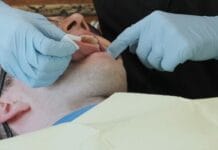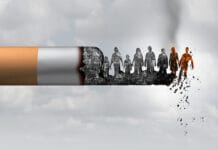Health-related misinformation is often associated with a need for more scientific understanding or evidence and professional consensus. If the misinformation is consistently reiterated, especially by health care professionals, the misinformation can be wrongly accepted as truth. Unfortunately, a lot of health misinformation can lead to adverse health outcomes.1
A systematic review examined “unfavorable beliefs that expectant or new mothers frequently hold about oral health and the safety of dental care during pregnancy.”1
The Review
An electronic search of four databases identified published studies ranging from 1984 through 2022. Additionally, citation tracing was conducted to identify relevant articles missed in the database search. A total of 45 studies were included in this systematic review. All studies included were cross-sectional in design, with 16 studies utilizing interview-administered questionnaires, 29 studies used self-administered questionnaires, and six studies were qualitative.1
The Results
The results were reported in multiple categories, including unfavorable beliefs about utilizing dental services during pregnancy, the impact of specific treatments on pregnancy, the effects of pregnancy on oral health, and other unfavorable beliefs related to oral health during pregnancy.1
Unfavorable Beliefs About the Utilization of Dental Services
Two domains were identified as being associated with unfavorable beliefs about utilizing dental care during pregnancy, including unfavorable beliefs about dental treatment and unfavorable beliefs about dental visits.1
Unfavorable beliefs about dental treatment included:1
- Dental treatment adversely affects the fetus/is not safe
- Dental treatment should be avoided during pregnancy
- Teeth should not be treated during pregnancy
- Pregnant women should seek dental care only in an emergency
Unfavorable beliefs about dental visits included:1
- Dental visits are not necessary
- Dental visits are unsafe, even when treatment only involves a “check-up”
- Dental visits should be avoided
Unfavorable Beliefs About Specific Dental Treatment
Multiple treatments were identified as concerning for pregnant patients in the studies reviewed. Studies evaluating beliefs regarding dental radiographs found a prevalence of unfavorable and false beliefs regarding dental radiographs during pregnancy, which ranged from 31% to 93%.1
Regarding dental anesthesia, the belief that it was hazardous to the fetus ranged from 25% to 95%. It was believed by many of the participants that dental anesthesia could cause a miscarriage. Additional beliefs included dental anesthesia would affect the development of the baby’s organs, and in general, it is not safe for pregnant people and/or the fetus.1
Several of the studies included in the review identified the false belief that dental extractions cause miscarriages as the most typical unfavorable belief. Unfavorable beliefs about dental extractions had a lower prevalence than false beliefs about dental radiographs and anesthesia, with between 6% and 80% of those who are pregnant reporting beliefs that dental extractions were somehow harmful.1
Other identified unfavorable beliefs included:1
- Dental restorations are not safe
- Prophy or non-surgical periodontal therapy is not safe
- The dental environment in general (noises, material, etc.) is harmful to the baby
Unfavorable Beliefs About the Impact of Pregnancy on Oral Health
Beliefs about the impact of pregnancy on oral health varied, as one study found 86% of participants believed that “at least one tooth is lost or destroyed in each pregnancy.” In contrast, another study found that no participants subscribed to this belief. Additionally, a firmly held belief identified in multiple studies was that gingival pain, bleeding, and swelling were normal during pregnancy.1
Other Oral Health-Related Unfavorable Beliefs
The most common belief was that the baby took the calcium from the mother’s teeth during pregnancy.1
Unfavorable beliefs about calcium included:1
- Dental caries/tooth loss is due to the loss of calcium
- Calcium is drawn out of the mother’s teeth during pregnancy
- Lost calcium can be replaced by swishing and keeping milk in the mouth
- Calcium supplements suffice to prevent dental problems
- Calcium consumption during pregnancy stimulates primary tooth eruption
Other unfavorable beliefs included:1
- Teeth should not be brushed after delivery (for a period of time)
- Teeth should not be brushed during pregnancy
- Uncomfortable feeling in teeth is because of “yeet hay” (internal heat)
- The mother’s diet during pregnancy affects the child’s tooth color
- Poor oral hygiene causes cavities that enter the abdomen and negatively affect the baby
Conclusion
Though these beliefs are often based on generational beliefs, social networks, and media, health care professionals have also contributed to the dissemination of misinformation regarding oral health care during pregnancy. This finding underscores the importance of improving oral health literacy among pregnant patients and some health care professionals.1
The prevalence of misconceptions and unfavorable beliefs about oral health during pregnancy also highlights the need to improve the understanding of oral health care in primary and prenatal health care settings. Encouraging preventative and restorative dental care for all pregnant patients through better education and referral to dental professionals, when necessary, could improve health outcomes for both the baby and pregnant patients. These interventions should address the specific, risk-based oral health needs of pregnant patients and their unborn children.1
Before you leave, check out the Today’s RDH self-study CE courses. All courses are peer-reviewed and non-sponsored to focus solely on high-quality education. Click here now.
Listen to the Today’s RDH Dental Hygiene Podcast Below:
Reference
1. Kamalabadi, Y.M., Campbell, M.K., Zitoun, N.M., Jessani, A. Unfavourable Beliefs About Oral Health and Safety of Dental Care During Pregnancy: A Systematic Review. BMC Oral Health. 2023; 23(1): 762. https://pmc.ncbi.nlm.nih.gov/articles/PMC10577919/











